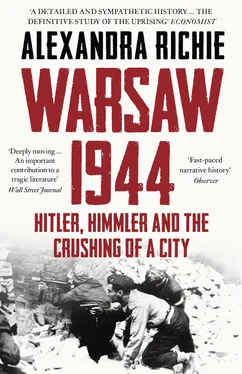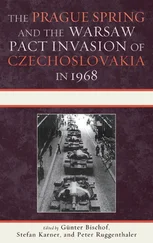Von dem Bach was right to fear for the mental health of his murderers: he himself would have to undergo treatment for the psychological trauma he suffered after witnessing so much killing. In Byelorussia the extermination of the Jews was done in broad daylight, and often in sight of the local population. In one of many reports, a District Commissar in Slutsk described how a police battalion had ‘fetched and carted off all the Jews … With indescribable brutality on the part of the German policemen as well as Lithuanian partisans (under the SS) the Jewish people, including Byelorussians, too, were brought together from their apartments. There was shooting all over town, and corpses of dead Jews piled up in several streets.’ People had been ‘buried alive’, and the police had looted the town. ‘The Byelorussian people, who had gained confidence in us, have been stupefied.’ The SD complained that the Byelorussians were ‘passive and stupid’, so that it was ‘virtually impossible’ to persuade them ‘to stage pogroms against the Jews’. In Minsk in 1942, Einsatzgruppe B decided to give Hitler a present by killing all the Jews in the city by his birthday, 20 April. The plan was stymied by the civilian occupation authorities under Wilhelm Kube, who wanted to save some Jews to be used as forced labour. On 1 March the Germans ordered the Judenrat – one of the councils which Jews were forced to set up in the occupied territories – to provide a quota of 5,000 Jews by the following day; when they did not, the Germans stabbed the children in the Jewish orphanage to death. 16
Gerhard Bast, a member of Sonderkommando B, took part in the murder of Jews in and around Minsk. One eyewitness testified after the war how Bast’s group had brought a group of Jews and gypsies in lorries and unloaded them near a freshly dug trench. ‘It was mainly women and children who were shot, some of them with babies.’ He could still picture the women ‘nursing their children on the way to the pit to calm them down. At the pit the children were torn from their mothers and were generally shot first, in front of their mothers. Very small children were held up by one arm by the SD men, shot in the head, and then carelessly tossed into the pit like a log.’ 17Bast was one of the many from Sonderkommando B who under Artur Nebe had worked closely with von dem Bach, and who would flee Byelorussia in the face of the advancing Red Army in 1944. He ended up in Warsaw in August, just in time for the uprising.
It is almost beyond belief that von dem Bach would declare at Nuremberg: ‘The whole crowd – Hitler, Himmler, Göring, Frank, Rosenberg, just to mention those who were responsible in the east alone – have blood on their hands. But I have none.’ Bach saw himself as a humanitarian family man who called his wife ‘ Mutti ’ and was close to his six children, to one of whom Himmler was godfather. And yet to mark his first Christmas in Minsk in 1941, this proud father sent 10,000 pairs of babies’ and children’s socks, and 2,000 pairs of shoes, as a gift to children of the SS in Germany, items which had been stolen from the condemned children of the Minsk ghetto. 18Some measure of his personal ‘hands-on’ participation is revealed in his own medical record. In early March 1942 he suffered a nervous breakdown, and had to be taken to the SS hospital in the erstwhile tuberculosis clinic at Hohenlychen, where he was treated by Ernst-Robert Grawitz, the SS chief medical officer and head of the German Red Cross. In his report to Himmler, Grawitz stated that Bach was ‘suffering particularly from hallucinations connected with the shootings of Jews which he himself carried out and with other grievous experiences in the east’. When Grawitz asked him why he was under such strain, Bach replied, ‘Don’t you know what’s happening in Russia? The entire Jewish people is being exterminated there.’ By the end of 1942, the Germans had killed at least 208,089 Jews in Byelorussia, and Bach had participated fully.
The ‘successful’ treatment of Russian prisoners of war, and the mass murder of the Jews in Byelorussia, led to von dem Bach’s next major promotion. As German brutality increased, so did resistance. The Germans had lost their chance to be treated as liberators, and had quickly turned themselves into loathed conquerors. As such, they were increasingly under attack by partisans. Something had to be done.
Von dem Bach and the Partisan War
The first partisans in Byelorussia were Red Army soldiers who had become trapped behind enemy lines in the first months of Barbarossa. While some of these joined the German side to avoid the atrocious conditions of the PoW camps, or out of conviction that Germany offered a better future, others remained loyal to the Soviet Union, and regrouped in secret to continue the fight. On 3 August 1941 Stalin recognized this phenomenon by declaring an official ‘partisan war’. ‘It is necessary,’ he said in a radio broadcast, ‘to create unbearable conditions for the enemy in the occupied areas.’ By the spring of 1942 the central headquarters of the partisan movement had been created at Stavka, the headquarters of the Soviet armed forces, headed by Panteleimon Ponomarenko. Groups of partisans were trained by the NKVD, SMERSH (the acronym for the Soviet counter-intelligence agency, ‘Death to the Spies’) and GRU, the Main Intelligence Directorate, and dropped behind enemy lines, and as German oppression worsened their ranks swelled. Many joined to avoid being press-ganged by the Germans as Hilfswillige – literally ‘those willing to help’ – and there were increasing desertions from the ranks of German-controlled military and police formations: the entire 1,000-strong Volga Tatar Battalion came over to the Russian side in February 1943. Around 10,000 Jews from Minsk also tried to join: men with weapons were taken, but most women and children who were hoping for protection were turned away, and had to eke out an existence in the forests and marshes nearby; many were later caught in German ‘combing’ operations and killed.
The huge area of uncharted forests and swamps of Byelorussia was ideally suited to partisan warfare. Small mobile units could race through the marshes and outmanoeuvre the Germans, who would get lost on unmarked trails and whose vehicles would get stuck in the mud. The partisans had special swamp clothing and boots which helped them walk in the sodden landscape. Using methods more reminiscent of Vietnam than the Eastern Front, they fashioned reeds into breathing tubes so that they could submerge themselves underwater until danger had passed. By the end of 1943 the partisans controlled vast areas behind the German lines, with sophisticated facilities and airstrips where the Soviets could land with supplies and men; by 1942 they already numbered around 100,000. Having learned that the Western Allies would not be opening the second front within the year, Stalin held a party for the partisans at the Kremlin in September 1942. They were, he said, to become a serious element of Soviet strategy – ‘a second front in the enemy’s rear’. 19
It soon became clear to the Germans that the partisans were more than a mere nuisance. As early as February 1942 Field Marshal Günther von Kluge, commander of Army Group Centre, complained to General Halder that far from limiting themselves to disrupting communications, the growing partisan bands were now attempting to bring ‘entire districts under their control’. For Hitler this was intolerable, and his answer was to order even more brutality. In August 1942 he placed anti-partisan warfare under the jurisdiction of the Army Operations Sections from the High Command down. In Directive no. 46, ‘Instructions for Intensified Action Against Banditry in the East’, released that month, he vested responsibility for the operational areas in the General Staff, while the SS was given overall command and responsibility for the extermination of the partisans. There would be no attempt to win them over. Being ‘weak’ had only led to failure in the past. In a top-secret supplementary order to the 18 October 1942 ‘Commando Order’, Hitler stated that ‘Only where the fight against this partisan disgrace was begun and executed with ruthless brutality were results achieved which relieved the positions of the fighting front. In all eastern territories the war against the partisans is therefore a struggle of absolute annihilation of one or the other party.’ As for enemy sabotage troops, they were to be exterminated, without exception, to the last man. ‘This means that their chance of escaping with their lives is nil.’ Hitler recalled watching as the ‘red bastards’ had placed children at the head of their march through Chemnitz in the interwar period in order to dissuade their opponents from attacking them. Faced with similar circumstances an officer must, he explained to Generals Keitel and Jodl in December 1942, be prepared to kill women and children in order to overcome a greater evil. Burning down houses with people inside was now a military necessity. On 16 December Keitel issued the last security order of the year. Partisans were to be eradicated like ‘pests’, and troops were granted the right to use all measures, even against women and children, if it led to success. They would not be punished, nor would they ever face trial. The level of brutality was set to escalate to astronomical levels.
Читать дальше





![Traudl Junge - Hitler's Last Secretary - A Firsthand Account of Life with Hitler [aka Until the Final Hour]](/books/416681/traudl-junge-hitler-s-last-secretary-a-firsthand-thumb.webp)






